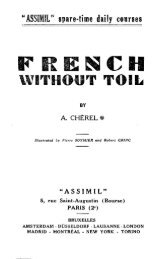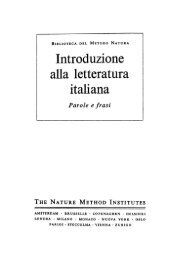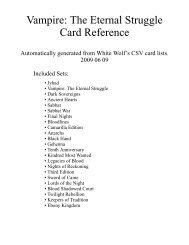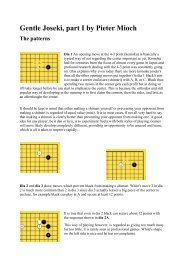Plains Cree: A Grammatical Study - Computer Science Club
Plains Cree: A Grammatical Study - Computer Science Club
Plains Cree: A Grammatical Study - Computer Science Club
Create successful ePaper yourself
Turn your PDF publications into a flip-book with our unique Google optimized e-Paper software.
12 [TRANS. AMER. PHIL. SOC.<br />
lar stretches of the story. New stories may be made<br />
up on the existing pattern.<br />
Several of these sacred stories have been recorded<br />
in more than one version. "Wisahkecahk and the<br />
Shut-eye dancers," for example, was recorded in at<br />
least two versions by Bloomfield (1930: pp. 34-40<br />
and 1934: pp. 282-284); twelve versions, of varying<br />
quality and length, were recorded in 1967-1968.<br />
The term acimowin is usually translated by in-<br />
formants as 'true story,' which may be taken to<br />
imply that texts of the sacred story type are not<br />
historical in the usual sense of that term. An<br />
dcimowin may concern any everyday event, it may<br />
be an anecdote, a funny story, or the like; but there<br />
is an important subclass of historical narratives, called<br />
kayds-acimowin 'old-time story.' These deal with<br />
military exploits of the horse-raiding days, or with<br />
other historical topics; they may be personal recollec-<br />
tions, or "recollections by proxy," passed on down<br />
the generations. That they contain magical experi-<br />
ences does not disturb their status as true stories.<br />
A final, non-native, subclass has for the moment<br />
been labeled "exhortatives"; they usually contrast<br />
the golden age of the buffalo economy with today's<br />
misery and, especially, alcoholism.<br />
1.4. ABBREVIATIONS AND CONVENTIONS<br />
1.41. <strong>Grammatical</strong> Information<br />
The use of technical abbreviations has been kept<br />
to a minimum.<br />
The verb classes are occasionally referred to by the<br />
following symbols:<br />
TA transitive animate<br />
TI transitive inanimate<br />
AI animate intransitive<br />
II inanimate intransitive<br />
WOLFART: PLAINS CREE<br />
The abbreviations of the person-number-gender-obviation<br />
categories (indf, 1, lp, 21, 2, 2p, 3, 3p, 3',<br />
0, Op, 0', O'p) are defined in table 1 of section 2.01;<br />
the choice of numbers should be largely selfexplanatory.<br />
In discussions of transitive animate (TA) verbs, a<br />
combination like 1-3 is to be interpreted as the first<br />
person acting on the third; an inverse action, with 3<br />
acting on 1, would be indicated by 3-1.<br />
Transitive animate (TA) verb forms which involve<br />
third persons exclusively, show only one of the referents<br />
morphologically expressed (cJ. sections 5.622 ff.).<br />
Textual examples, however, will be more intelligible<br />
if the syntactic referents (rather than merely the<br />
significative and morphological status of the verb<br />
form) are indicated. That referent which is not<br />
expressed morphologically, is enclosed in parentheses,<br />
e.g.<br />
direct: -ew TA 3-(3')<br />
-eyiwa TA 3'- (3')<br />
inverse: -ik TA (3')-3<br />
-ikoyiwa TA (3')-3'<br />
For transitive inanimate (TI) verbs, only the actor<br />
is indicated (e.g., TI 2p) since the number and obviation<br />
distinctions of the inanimate goal are not morpho-<br />
logically reflected in the verb (cf. 5.13).<br />
When cited in isolation, verbs are generally in-<br />
flected for a third person actor; nouns and pronouns<br />
are given in the proximate singular.<br />
In <strong>Cree</strong> forms, leading or trailing hyphens indicate<br />
that a segment is not a free form; when a form is<br />
cited in morphophonological representation, leading<br />
or trailing hyphens are usually omitted. In phonemic<br />
representation, a hyphen within a word marks it as<br />
compound (6.5).<br />
We use Bloomfield's orthography (cf. appendix A<br />
and Bloomfield, 1930: pp. 2-6) except for the purely<br />
mechanical substitution of o, e, and c for his u, d, and<br />
ts. Phonemic representation is indicated by italics.<br />
This mode of representation14 is used throughout, even<br />
when strings smaller than words are cited. Morpho-<br />
phonological notation, namely strings enclosed in<br />
slashes (and the additional characters /e/, /0/, /L/),<br />
is used only where it is immediately relevant to the<br />
discussion; cf. appendix A.<br />
1.42. Text References<br />
Most of the illustrative material is quoted from<br />
the texts (see below). Examples which are not<br />
specifically identified are taken from my field notes.<br />
An identification included in parentheses, e.g.<br />
(T55p62), means that the form is not cited verbatim<br />
but regularized or in a citation form. Glosses are not<br />
necessarily uniform throughout.<br />
Although unpublished, the texts collected by<br />
myself are identified by a number preceded by T,<br />
e.g. T105. Since they are in varying states of editing,<br />
reference is sometimes made to paragraphs (by a<br />
hyphen) and sometimes to pages (by the letter p).<br />
Thus, 105plO refers to page 10 of text 105, and<br />
T91-6 refers to paragraph 6 of text 91.<br />
Bloomfield's published texts are identified by S for<br />
Sacred Stories of the Sweet Grass <strong>Cree</strong> (1930) and by P<br />
for <strong>Plains</strong> <strong>Cree</strong> Texts (1934). Citation is by page<br />
and line, e.g. S247-34.<br />
Passages from the texts are left exactly as originally<br />
printed except for obvious misprints and the me-<br />
chanical replacement of certain symbols; see 1.41<br />
above. Note especially the frequent writing of final h<br />
in Bloomfield's texts; cf. appendix A and Bloomfield<br />
1930: pp. 2, 3.<br />
2. GRAMMATICAL CATEGORIES<br />
The major grammatical categories of <strong>Cree</strong> are<br />
gender, number, person, and obviation. The cate-<br />
14 Cf. appendix A, footnote 85.









